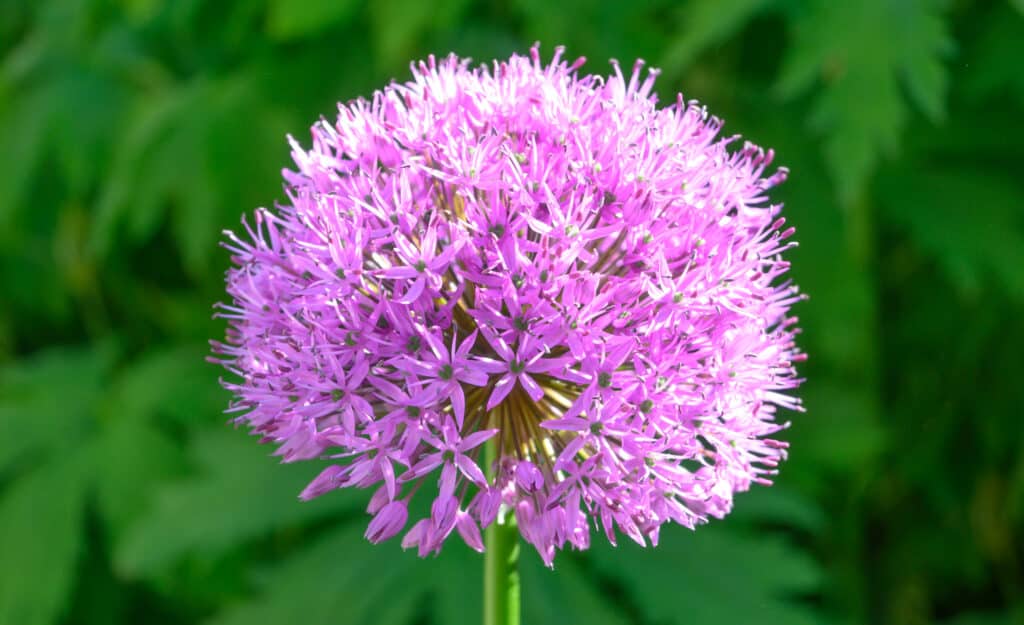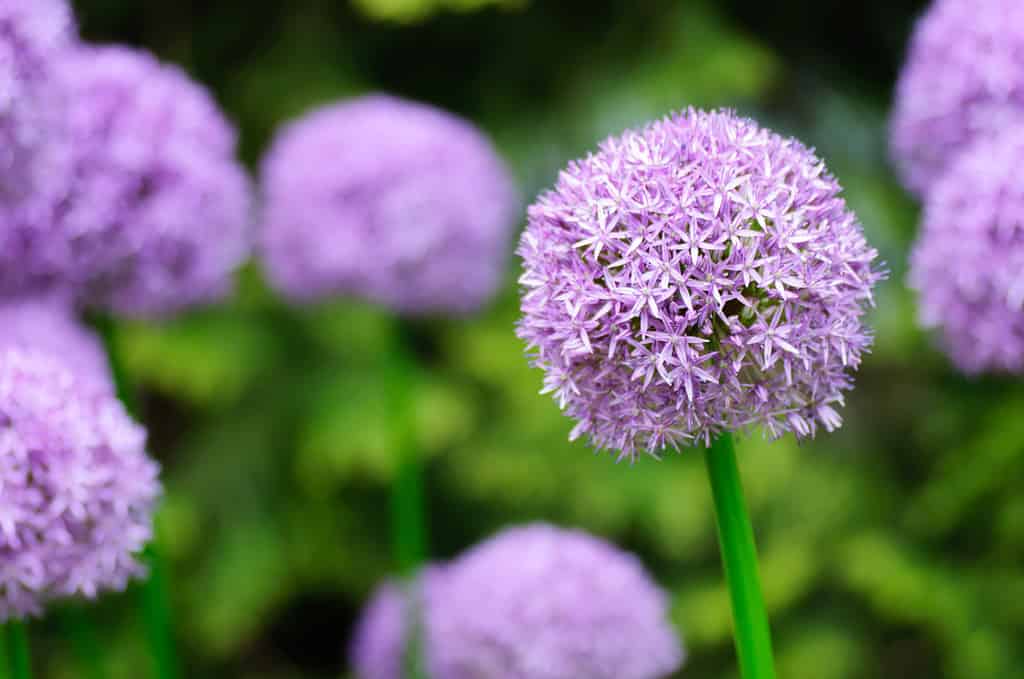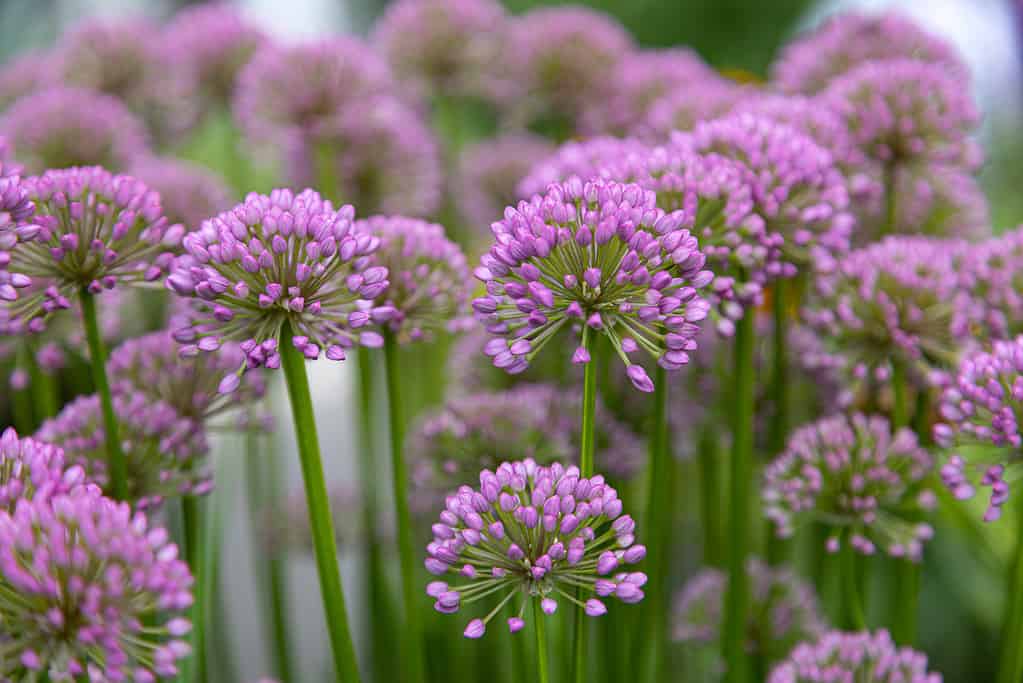Some of the most gorgeous blooms we grow in our gardens belong to vegetable plants or at least their ornamental counterparts, like the allium, which is technically an ornamental onion. The puffy stars of yellow, white, pink, purple, or blue belong to a section of the plant kingdom we usually reserve for the dinner table.
So, what are these allium bulbs, how should they be cared for, and which varieties are the best for home gardens? Let’s take a look so that you may discover your best options.

Wild Leek Allium ampeloprasum with vivid magenta-pink puffball bloom
©iStock.com/Lynne Nicholson
| Botanical name | Allium |
| Popular varieties | Allium schubertii, Allium bulgaricum, Allium ‘Globemaster’, Giant onion, Drumstick allium, Allium caeruleum, Turkistan onion, Allium christophii, Purple Sensation, Star of Persia, Allium ‘Mount Everest’, Allium Globeprimary, Blue Allium, Chives, Allium moly, Karataviense, Pink Lily Leek, Three Cornered Leek, Allium Millenium, Crow Garlic Hair, Allium ‘Gladiator’, Allium ‘Red Mohican’, German garlic, Ornamental onion, Allium ‘His Excellency’, Allium cernuum, Allium ‘Mont Blanc’, Allium nigrum, Allium nevskianum, Allium ‘Dready’ |
| Light needs | They full require sun but may tolerate partial shade in certain circumstances. |
| Water needs | The bulbs need watered regularly but never kept soggy. |
| Soil needs | Plant allium bulbs in well-draining, moist but not waterlogged soil. |
| USDA Hardiness Zones | 3 to 8 |
| Beginner friendly? | Yes |
| Special care notes | They must have some time to grow dormant in cooler seasons in order to properly produce and thrive. |
| Colors | white, yellow, pink, purple, blue |
What Are Allium Bulbs?

Giant Purple Allium Flowers in a garden
©iStock.com/jamesvancouver
Also known as the ornamental onion, allium bulbs are vividly colored plants that grow up in spring and summer, producing vibrant blooms in white, pink, yellow, purple, and blue. Making up the largest genus in the Amaryllidaceae family, the genus known as Allium contains several hundred species, anywhere from 260 to nearly 100, depending on some details that make classification technically challenging. The genus originally was described by Carl Linnaeus in 1753, with the name coming from Greek for the word meaning “to avoid” (aleo) due to the pungent aroma.
Naturally occurring primarily in temperate climates in the Northern Hemisphere, allium flowers are called umbels. They grow atop leafless stalks springing from small to large bulbs, depending on the cultivar or species. Allium produce chemical compounds that give them the pungent smell and flavor associated with onions and garlic.
What Is a Bulb?
The term “bulb” is applied to many different types of plants, with several variations of “true bulbs” to rhizomes. However, all have this in common: they store their complete life cycle in an underground structure.
- True bulbs – lilies, tulips, muscari, hyacinth, allium, daffodils
- Corms – crocus, autumn crocus, gladiolus, tuberous begonias, taro
- Tubers – potatoes, oxalis, anemones, caladiums, dahlias, daylilies, peonies
- Tuberous roots – airplane plant, asparagus, some irises
- Rhizomes – irises, canna lilies, ginger, bamboo, bearded irises
- Fleshy roots – carrots, radishes, some peonies, some daylilies,
What Are Alliums Used For?

Some varieties of alliums develop “aerial bulbs”
©iStock.com/Orest Lyzhechka
Considered ornamental in many cases, alliums may be used for a variety of purposes. Some species are the typical edible onions and garlic plants, with others used as spices, medicinal plants, and vegetables. The blossoms are favored among gardeners, as well, with the vibrantly colored pom-pom like blooms. Border plantings, ornamental gardens, vegetables gardens, and container gardens might find these stunners in them. They aren’t often grown indoors, however, because of that pungent aroma they’re famous for.
Varieties or Types of Alliums
Many varieties of allium are available, both ornament and edible.
- Allium schubertii
- Allium bulgaricum
- Allium ‘Globemaster’
- Allium giganteum – Giant onion
- Allium sphaerocephalon – or drumstick allium
- Allium caeruleum
- Allium karataviense – Turkistan onion
- Allium christophii
- Allium hollandicum – Purple Sensation
- Allium cristophii – Star of Persia
- Allium ‘Mount Everest’
- Allium Globeprimary
- Allium caeruleum – Blue Allium
- Allium schoenoprasum – Chives
- Allium moly
- Allium karataviense – Karataviense
- Allium oreophilum – Pink Lily Leek
- Allium triquetrum – Three Cornered Leek
- Allium Millenium
- Allium vineale ‘Hair’ – Crow Garlic Hair
- Allium ‘Gladiator’
- Allium ‘Red Mohican’
- Allium Senescens – German garlic
- Allium atropurpureum – Ornamental onion
- Allium ‘His Excellency’
- Allium cernuum
- Allium ‘Mont Blanc’
- Allium nigrum
- Allium nevskianum
- Allium ‘Dready’
How to Care For Allium Bulbs

Macro of blooming onion flower head in the garden.
©iStock.com/Mariia Romanyk
Caring for allium bulbs is reasonably easy, with basic needs met through a sunny location, proper watering, and well-draining soil.
Light Requirements
To help your allium bulbs thrive, plant them in sunny locations where they’ll receive at least 6 to 8 hours of direct sunlight per day.
Water
When it rains, it pours and alliums shouldn’t be watered on those weeks when the droplets are provided by the heavens. Otherwise, water the puffy flowering plants about once a week in dry conditions and about once weekly in normal precipitation settings.
Soil Conditions
Well-draining soil is the primary need of allium bulbs. Otherwise, they’re not too picky about soil type, though they shouldn’t ever be over watered as this will destroy the bulbs.
Fertilizer
Well-draining soil, as mentioned, is needed for alliums, with some fertility in the soil provided by natural compost. Apply fertilizer to established alliums in springtime for summer plants and fall for winter blooms. Add more fertilizer once flowering has ended.
How to Propagate

Allium come in many colors.
©iStock.com/jokuephotography
Flowering ends and leaves fall, signaling the time to propagate your allium bulbs. Divide and plant the bulbs directly in new positions if growing outdoors or place in pots with gritty compost if preparing for a new season when too cold to grow outdoors.
The photo featured at the top of this post is © iStock.com/Lynne Nicholson
Thank you for reading! Have some feedback for us? Contact the AZ Animals editorial team.






